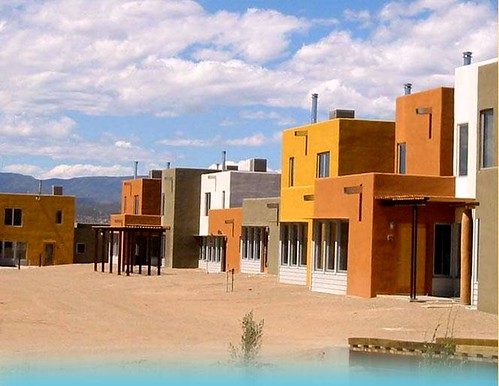Ohkay Owingeh project garners award for combining contemporary and traditional touches—and for solving a housing crisis through creative fundraising
By Ana Maria Trujillo
Duran also had public dialogue with community elders and other community members to ask them about what it was like to live in the pueblo and to get their ideas about the new community.
The design that came out of all those events was something that reflected traditional pueblo living—attached units divided around two plazas, one oriented to the solstice and the other to the equinox, which is a feature, Duran said, that was part of the original pueblo. The 40-unit development offers one-, two-, three- and four-bedroom apartments. Six hornos (outdoor ovens) are available for tenants to use throughout the property. A community meeting space, playground, computer room, weight room, business center and laundry facility are available to residents. Residents must be members of the tribe, and if a nonmember wants to move in with a member, he or she must get approval from the Tribal Council. Rent for the units ranges from $204 to $576 a month, Apodaca said.
Below: "Tsigo bugeh Village in Ohkay Owingeh has features of traditional pueblo living, including attached units divided by two plazas, one oriented to the solstice and the other to the equinox. Also, six hornos are available for the development's residents to use."


1 comment:
For more on the subject, see:
http://switchboard.nrdc.org/blogs/kbenfield/a_new_native_american_village.html
A new Native American village based on tradition helps a Tribe reclaim its sustainable roots
The Ohkay Owingeh Tribe and Pueblo in New Mexico has returned to its roots with an award-winning, mixed-income housing project based on traditional Native forms. It's an exciting and inspiring project.
Built by the Ohkay Owingeh Housing Authority explicitly as an alternative to sprawl-type housing, Tsigo Bugeh Village is a $5.3 million residential community that reflects traditional pueblo living with attached units divided around two plazas, one oriented to the solstice and the other to the equinox, as the tribe’s original pueblo was built. As the Housing Authority’s website points out, the homes are attached, their scale and massing similar to the original Ohkay Owingeh pueblo: “this is key to our architectural heritage, and the idea of community living that is central to our way of life.”
Post a Comment